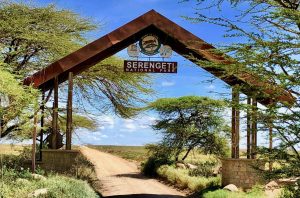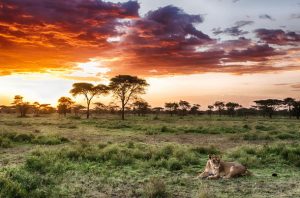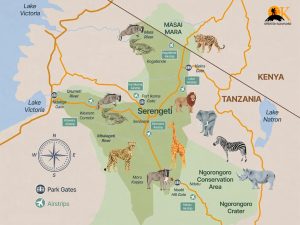Serengeti National Park
 The Serengeti National park is African Paradise and one of the seven natural wonders of Africa and the World. World heritage site, Man and Biosphere Reserve. Visiting the park will reward you and breathtaking for its unique biodiversity and physical features from plains to rolling hills, valleys and mountains. Serengeti offers several tourism products.
The Serengeti National park is African Paradise and one of the seven natural wonders of Africa and the World. World heritage site, Man and Biosphere Reserve. Visiting the park will reward you and breathtaking for its unique biodiversity and physical features from plains to rolling hills, valleys and mountains. Serengeti offers several tourism products.
The park is located in the Northern Part of Tanzania, and it’s boarded by three regions which are Mara, Simiyu and Arusha. Serengeti is the oldest Park in Tanzania and well known worldwide especially for being a heart of the only great wildebeest migration remained in the World to date. It is also forming a heart of Serengeti Mara Ecosystem that includes Ngorongoro Conservation Area, Loliondo Game Controlled, Maasai Mara National Reserve, Ikorongo Game Reserve, Grumet Game Reserve, Kijereshi Game Reserve and Maswa Game Reserve.
The popular activity in the Park is game viewing enhanced by malt Game circuits connecting the Main Roads from Naabi Hill Gate – Ikoma Gate, Naabi Gate – Ndabaka Gate, Kleins – Ikoma Gate. However, the main entrance is the Naabi Hill Gate connecting Ngorongoro Conservation Area and the Serengeti National Park.
Park History
The name Serengeti comes from the Maasai word “Siringeti” referring to an “Endless Plain”. As you stand on the Southern grass plains, you experience this vastness, and can witness one of the greatest concentrations of plain animals left on earth. The plains were formed 3-4 Million years ago when ash blown from Volcanic mountains of Ngorongoro highlands. The thick layer of ash preserved traces of early man, and established the rich soil which supports the growth of short grasses in Southern plains. From this early beginning, man and wildlife have shared this magical place.
In recognition of the need to preserve this special area, The Central Serengeti was declared a Game Reserve in 1929.
 In 1951, the Reserve became Tanganyika’s first National Park, and in those days included the Ngorongoro Crater. Further alteration in 1959 resulted in the Park boundaries you see today. Part of the Serengeti plains and the highlands were designated to the Ngorongoro Conservation Area, while extensions to the North and South were included to provide more protection to Migratory animals. Covering approximately 14,763 Square Kilometres, the Park is roughly the size of Northern Ireland or Connecticut, making it Tanzania’s second largest national park.
In 1951, the Reserve became Tanganyika’s first National Park, and in those days included the Ngorongoro Crater. Further alteration in 1959 resulted in the Park boundaries you see today. Part of the Serengeti plains and the highlands were designated to the Ngorongoro Conservation Area, while extensions to the North and South were included to provide more protection to Migratory animals. Covering approximately 14,763 Square Kilometres, the Park is roughly the size of Northern Ireland or Connecticut, making it Tanzania’s second largest national park.
The Park is the Centre of the Serengeti ecosystem as the core area. Roughly defined by the annual Wildebeest Migration, the Serengeti ecosystems is expansive – and area of approximately 25,000 – 30,000 Square Kilometres. It is the combination of Serengeti National Park with its buffer zones –Ngorongoro Conservation Areas, four Game Reserves, one Game Controlled Area and Kenya’s Maasai Mara National Reserve – that protects the largest single movement of wildlife on earth.
The Serengeti was first inhabited by the ancient hunter gatherers and more recently pastoralists. The plains were controlled by the Maasai. There are early Maasai rock paintings still visible at Moru and a special rock used for making different sound (Gong! Gong!). The colonist who arrived by the early 1900’s found a land virtually untouched, and exploited it for exceptional hunting opportunities, particularly Lion, Leopard and Buffalo. Serengeti offers more than just an annual migration. Its colourful topography of Mountains, Rolling Hills, Rivers and Plains provide year-round habitat for many of the Serengeti’s wildlife species.
How to Get in Serengeti
 The Park can be accessed by Air and by road through fifteen (15) entry points. By Air the Park is accommodating Seven (7) Airstrips which can be accessed from all Local and International Airports in the country. By road the park can be accessed through eight gates (8) which are Naabi Hill Gate, Ikoma gate, Ndabaka Gate, Kleins Gate, Tabora B, Lamai Gate, Handajega Gate and Ndutu Gate.
The Park can be accessed by Air and by road through fifteen (15) entry points. By Air the Park is accommodating Seven (7) Airstrips which can be accessed from all Local and International Airports in the country. By road the park can be accessed through eight gates (8) which are Naabi Hill Gate, Ikoma gate, Ndabaka Gate, Kleins Gate, Tabora B, Lamai Gate, Handajega Gate and Ndutu Gate.
The distance from Arusha to Naabi Gate is 272km through Ngorongoro Conservation Area, from Arusha to Kleins Gate 420km, from Mwanza to Ndabaka Gate 141km, From Mwanza to Ikoma gate through Mugumu District 253km. From Sirari Boarder to Ikoma is approximately 158km via Kiabakari – Butiama and Mugumu. From Sirari – Ikoma Gate via Nyamongo, Mugumu 138km. From Sirari – Lamai Gate via Nyamongo 67km.
Why Visit the Serengeti?
- The Great Migration – Witness one of nature’s most awe-inspiring events as massive herds cross the plains, braving predators and the treacherous Mara River.
- Big Five Game Viewing – Spot lions, elephants, leopards, rhinos, and buffalo in their natural habitat.
- Diverse Landscapes – Explore the vast savannas, acacia woodlands, and riverine forests that provide breathtaking scenery.
- Exclusive Safari Experience – Enjoy game drives, walking safaris, and hot air balloon rides over the Serengeti for an unforgettable adventure.
- Rich Cultural Encounters – Engage with the Maasai people, known for their deep-rooted traditions and unique way of life.
 What to See in Serengeti?
What to See in Serengeti?
- The Central Serengeti (Seronera) – The heart of the park, home to year-round game viewing, including big cats like lions and cheetahs.
- Northern Serengeti – A prime location to witness the dramatic Mara River crossings from July to October.
- Western Corridor – Known for its riverine forests and the Grumeti River, where large crocodiles await migrating herds.
- Southern Serengeti & Ndutu Region – A calving ground for wildebeest from December to March, attracting numerous predators.
Best Time to Visit Serengeti National Park
The Serengeti offers incredible wildlife viewing all year round, but the best time depends on what you want to experience:
- December to March – Ideal for witnessing the wildebeest calving season in the Southern Serengeti, attracting predators like lions and hyenas.
- April to May – A quieter period due to the long rains, but the park is lush and less crowded, offering excellent photography opportunities.
- June to October – Peak dry season and the best time for general game viewing, including the dramatic Mara River crossings in the north.
- November – The short rains bring fresh greenery, and the herds start moving south again, making for scenic safari experiences.
Plan Your Serengeti Adventure with Operation Kilimanjaro
For a truly immersive safari experience, Operation Kilimanjaro offers expertly guided tours that combine Serengeti safaris with Mount Kilimanjaro treks and other Tanzanian adventures. Whether you seek a private luxury safari or a budget-friendly adventure, Serengeti National Park promises an unparalleled wildlife experience.

